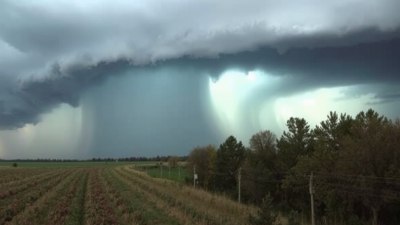Why Cloud Shapes Change With Shifting Temperatures
Explore how temperature fluctuations influence cloud shapes and their significance in weather patterns.

Clouds are a fundamental aspect of our atmosphere, acting as indicators of weather and mood alike. They are not static; instead, they are constantly morphing, growing, and dissipating. The shapes and types of clouds we observe in the sky are significantly influenced by changing temperatures. Understanding why cloud shapes change with shifting temperatures requires a basic knowledge of how clouds are formed, what factors influence their characteristics, and how temperature plays a critical role in this dynamic process.
The Basics of Cloud Formation
Clouds form when water vapor in the air condenses into tiny water droplets or ice crystals. This condensation occurs when the air is cooled and can no longer hold all its moisture, resulting in the formation of clouds. The specific conditions under which clouds form significantly influence their shape and type. Temperature is one of the primary factors in this process, as it affects both the amount of moisture in the air and the clouds' thermal dynamics.
Different Types of Clouds
Clouds are classified into several types, each with unique characteristics influenced by temperature and altitude. The main categories include cirrus, cumulus, stratus, and nimbus clouds. Cirrus clouds, for instance, are thin and wispy, typically forming high in the atmosphere where temperatures are very low. In contrast, cumulus clouds are puffy and fluffy, forming at lower altitudes where the temperatures are warmer. Understanding these classifications allows us to comprehend the relationship between temperature and cloud shapes better.
Temperature and Cloud Density
The temperature of the atmosphere affects the density of air, which can impact cloud formation. Warmer air is less dense than cooler air, allowing it to rise more easily. As warm air rises, it expands and cools, eventually reaching the dew point where condensation occurs and clouds form. If temperatures are cold enough, the water droplets within the cloud can freeze and form ice crystals, resulting in different cloud types, such as cirrus or cumulonimbus clouds, which can indicate stormy weather.
The Role of Humidity
Humidity also plays a critical role in cloud formation. The higher the humidity in the air, the more water vapor is available for condensation. In warm temperatures, when the air holds more moisture, clouds can become thicker and larger. Conversely, in cooler temperatures, the air is less humid, leading to thinner, less dense clouds. This relationship between humidity and temperature is essential for understanding why cloud shapes change: as temperatures fluctuate, so too does the humidity, directly influencing cloud density and structure.
Vertical Development of Clouds
The vertical development of clouds is another aspect greatly influenced by temperature changes. When warm air rises vigorously, it can create towering cumulus clouds that may develop into cumulonimbus clouds, associated with thunderstorms. On the other hand, if the temperature gradient in the atmosphere is stable—where warm air is trapped beneath a layer of cooler air—this can lead to the formation of stratus clouds, which are flat and cover the sky like a blanket, indicating less turbulent weather.
Temperature Inversions
Occasionally, the atmosphere experiences temperature inversions, where cooler air is trapped near the surface while warmer air resides above. This inversion can create unique cloud formations. For instance, fog or low stratus clouds often form in these conditions, leading to flat, featureless cloud layers. In contrast, when the inversion breaks down, it can lead to rapidly changing weather patterns, causing cloud shapes to shift dramatically as the warm air begins to rise.
Impact of Climate Change
Climate change is altering global temperatures and, consequently, the behavior of clouds. As temperatures rise, the atmosphere can hold more moisture, potentially leading to more intense precipitation events and changes in cloud formation. For example, warmer temperatures can enhance the likelihood of producing larger cumulus clouds that develop into more severe thunderstorms. The changing climate prompts further investigation into the relationship between temperature variations and cloud formation, as continued warming may disrupt established weather patterns.
Understanding Weather Patterns
The shape and type of clouds formed at any given moment provide critical clues about upcoming weather. Meteorologists analyze cloud types to predict changes in climate conditions. For example, the presence of large cumulonimbus clouds often signals impending severe weather events, while the appearance of cirrus clouds may indicate fair weather. Because temperature changes affect cloud formation and their characteristics, monitoring them helps improve weather forecasting accuracy.
Cloud Seeding and Temperature
Cloud seeding is a technique used to enhance precipitation from clouds. This method involves introducing substances (like silver iodide) into clouds to encourage the condensation of water droplets. Temperature plays a crucial role in the efficacy of cloud seeding. When seeding occurs in warm, moist air, the chances of increased precipitation rise significantly. Conversely, attempting to seed clouds in colder air can lead to less accessible moisture, making the process less effective.
The Aesthetic Aspects of Clouds
Besides their meteorological importance, clouds also possess aesthetic qualities that are influenced by temperature and light. For instance, during sunset, clouds can take on brilliant hues due to the scattering of light. Temperature can affect the appearance of clouds as well. Colder air can lead to clearer skies, allowing for sharper, more defined cloud shapes, while warmer temperatures can create haze, softening their outlines. This interplay between temperature and aesthetics is why cloud watching remains a popular pastime.
The transformation of cloud shapes in response to shifting temperatures is a fascinating aspect of meteorology. Understanding the mechanics of cloud formation and the roles temperature, humidity, and atmospheric dynamics play can enhance our appreciation for clouds and their impact on weather patterns. By studying these relationships, we can better predict weather changes and appreciate the beauty inherent in our sky’s ever-evolving canvas.











